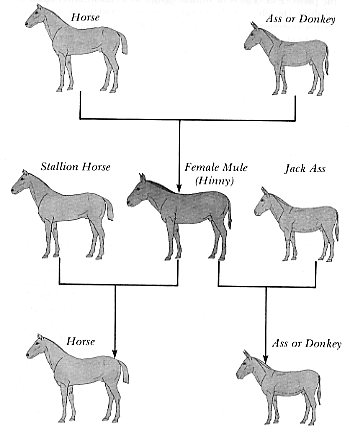Horses, Mules, and… Donkeys?
by Matt Mattson
 I’m no livestock expert. Let me start out by admitting that. I talk to some students occassionally, however, that have a lot of experience with livestock and they often like to correct my lack of equine experience. This conversation will often come up following a Dynamic Recruitment Workshop that includes the analogy of Horses vs. Mules (get some info on this here.)
I’m no livestock expert. Let me start out by admitting that. I talk to some students occassionally, however, that have a lot of experience with livestock and they often like to correct my lack of equine experience. This conversation will often come up following a Dynamic Recruitment Workshop that includes the analogy of Horses vs. Mules (get some info on this here.)
In our analogy of Horses vs. Mules we often teach that there are two types of members — HORSES that make up 10%-20% of the chapter but account for 80%-90% of the results, and MULES… the rest of the members. Our most important message in that analogy is that HORSES RECRUIT HORSES while MULES RECRUIT MULES. So, instead of the horses spending all their time trying to push or pull their unmotivated mules to just show up for recruitment work, simply GATHER YOUR HORSES AND GET TO WORK. You can get more results by recruiting with your MOTIVATED MEMBERS than you can trying to motivate your mules. Your horses are who you want on the front lines of recruitment anyway.
I had an undergraduate fraternity gentleman challenge this assertion recently. He was one of those livestock/equine experts, and he pushed me to re-think our analogy. Devin Patton, a member of Alpha Gamma Rho at University of Idaho shared these thoughts with me over E-mail today.
Coming from a livestock background I thought to myself, mules aren’t worthless. And coming from living within a fraternity I also thought that there aren’t just people who work hard and people who do nothing. So I started trying to figure out a better way to explain this so I could bring it up to Matt after we were finished.
To me a mule is an animal that is half a horse, so it has some ability within it to do a good job working. But on the other hand it is half donkey, so it is half an ass. I’ve spent a little time packing mules recently and I came to the conclusion that while mules aren’t the type of animal that is going to put out all of its effort and energy to the cause at hand. You can still take several mules, tie a pretty heavy load to their backs, and lead them along with a horse. Even average mules will just line out and follow packing their load, and a lot of times they will do this better than most horses, but there has to be a leader showing the mules where to go.
I began thinking the similarities and my perceptions of the type of men that live in most fraternities. And I thought, there are guys in fraternities who when given a job, they will do their job very well, but as soon as the job is done they go back to doing nothing until a leader gives them another job. I thought well that sounds a lot like a mule to me.
After the presentation was over I presented my case to Matt for him to change his presentation, and to change his definition of a mule. Surprisingly he agreed with my idea about three kinds of fraternity men. And after I explained that mules aren’t the worthless animals, that those are the donkey’s, he started laughing and said nobody had explained that to him before but it explains a fraternity house a little more in depth than just horses and mules.
There are horses who are the leaders within the fraternity who may not have the most skill, but they put forth the most effort and are willing to go to their limits if need be. Then there are the mules, which with a horse leading them have the ability to pack a pretty heavy load and do a good job. Which leaves me with the donkeys; the donkeys are the true worthless animals. Granted sometimes you might get a donkey to do some sort of work, but donkeys have a bad habit of just deciding to quit at the most inopportune times creating a lot more work for all the others involved in the situation. So just remember, if you have a mule who is half-assing it sometimes, that is just because it is half an ass. Just be glad you don’t have a donkey on your hands for they are complete asses.
So, perhaps there are horses, mules, and donkeys/asses. I still assert that you want your horses on the front lines of recruitment so you are sure to get horses in return. However, Devin’s lesson is that good leaders (stallions) can give specific tasks to some of the mules, and they’ll carry that load. There are jobs to be done that mules should do. There is leadership that should be done by horses. Then there are the asses in your group.
I’m still confused by all the different actual variations of real-life stallions, horses, donkeys, mules, asses, jack-asses, etc. But I do know that unmotivated members are NOT a valid excuse for recruitment underperformance. Gather your horses, assign tasks to your mules, and leave the barn door open for your donkeys as you just go out and get to work recruiting more high performing members.
